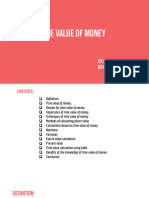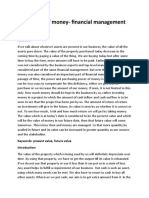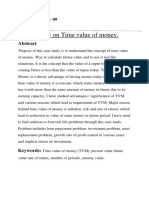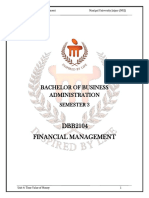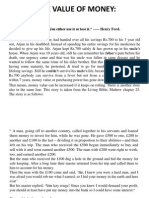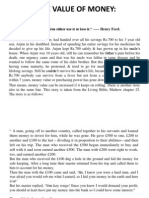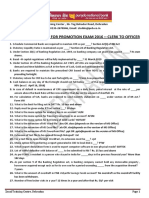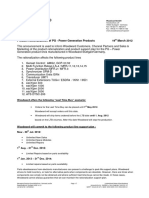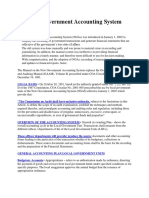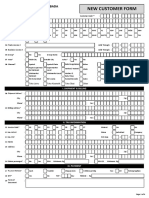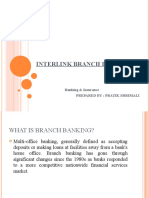Time Value of Money December 30, 1899
KLE SOCIETY’S DEGREE COLLEGE
Permanently Affiliated to Bangalore Univrsity
Nagarabhavi, Bengaluru-72
Department of UG
Bachelor of Commerce
SUBJECT
3rd SEM SEP-FINANCIAL MANAGEMENT
Mrs. SUMA N., M.Com , KSET, (MBA).
Assistant Professor
Department of Commerce
Financial Management 1
�Time Value of Money December 30, 1899
MODULE 2: TIME VALUE OF MONEY
INTRODUCTION
Time value of money is the common description for the general rule that cash in hand today is worth
more than the same amount of cash in the future. The concept of the time-value of money is used for
investment decisions.
The concept of time value of money can also be described as the value of money received today has
more value than the value of money received tomorrow. In short, the value of money depreciates with time.
The concept of time value of money is helpful in estimating the current worth of a future sum of money or a
cash flow stream at a specific rate of Interest. The future cash flows are discounted at the discount rate. A
higher discount rate indicates a lower present value of the future cash flows.
The time value of money refers to the value of money existing in a given amount of interest which is
earned during a specific time period. The time value of money can be explained as the central concept in
finance theory. Moreover, the concept of time value of money also helps in evaluating a likely stream of
income in the future in a manner that the annual incomes are discounted and added thereafter, thereby
providing a lump-sum present value of the complete income stream.
Two factors typically contribute to the time value of money:
In a period of inflation, cash will have lower purchasing power in the future.
The cash could always be invested in a risk-free alternative instead of the investment under
consideration. The interest that you would receive from the risk-free choice is a baseline. Any other
investment must be compared against that baseline.
Meaning of Time Value of Money
“Time value of money refers to "time has got a value". The rupee value keeps on changing over a period
of time. The purchasing power of a rupee, is there increase or decrease but never remains constant”.
The concept of time value of money refers to the money received today is different in its worth from the
money receivable at some other time in future. In other words, the same principle can be stated as that money
receivable in future is less valuable than the money received today.
NEED FOR TIME VALUE OF MONEY
Reinvestment opportunities: Money received today can be re-invested to get further return. If the rate
of return is greater than zero, money has a net productivity of time, because a given sum of money two
points of time does not have the same value. It means that with the availability of profitable investment
opportunities, a given sum of money can always be made to grow with the passage of time.
Uncertainty: The present is more certain than the future which is full of imponderables. As a result,
there is a general preference for present rupees of future rupees which may or may not be received in
full because of uncertainty.
Financial Management 2
�Time Value of Money December 30, 1899
Inflation: During inflation, the value of money goes decreasing or the price level goes on increasing.
As a result, people generally prefer the present to the future.
Personal consumption preference: Mainly individuals have a strong preference for immediate rather
than delayed consumption. The promise of a boil of rice next week counts for likely to the starving
man.
REASONS FOR TIME PREFERENCE FOR MONEY
There are basically three reasons for the time preferences of money:
1. Risk: People are not ready to take risk in financial related matters and the gives more weightage to the
present worth of money, as risk is attached with the rec of cash because of the business risk.
2. Inflation: Inflation implies that the purchasing power of a rupee will decline future, since the same rupee
one will not be enough to purchase the s commodity at a future date.
3. Preference for present consumption and satisfaction: present consumption satisfaction is more important
than future consumption and satisfaction as future uncertain.
CALCULATION OF TECHNIQUES IN TIME VALUE OF MONEY
There are basically two techniques for calculation of time value of money:
1. Compounding Technique (Future Value).
2. Discounting Technique (Present Value Technique).
COMPOUNDING TECHNIQUE
Compound value concept is used to find out the future value of present money. It is the same as the
concept of compound interest, wherein, the interest earned in preceding year is reinvested at the prevailing rate
of interest for the remaining period.
Thus, the accumulated amount (principal + interest) at the end of a period becomes the principal amount
for calculating the interest for the next period.
The compounding technique is to find out the future value (FV) of the present worth of money, can be
explained with reference to:
a) The future value of a single present cashflows.
b) The future value of annuity/series of cashflows.
c) The future value of multiple cashflows.
FUTURE VALUE
Future value is the value of an asset at a specific date which measures the nominal future sum of money
wherein the sum of money is worth at a specified time in the future assuming a certain interest rate or more rate
Financial Management 3
�Time Value of Money December 30, 1899
of return. It is the present value multiplied by the accumulation function. The values do not include corrections
for inflation or other factors that affect the true value of money in the future. This is used in time value of
money calculations.
The present value grows into the future value by the action of compound interest. This relationship
can be turned the other way about and we can say that the future value can be discounted back to its equivalent
present value. This relationship between Future Value and Present Value is fundamental to the measurement of
the time value of money.
MEANING OF FUTURE VALUE
The future value refers to the value of an asset or cash at a particular date in the future which is
equivalent to the value of a specified sum at present. The future value can also be explained as the amount of
money which will be reached by a present investment as a result of its growth in the future. As money features
time value, the future value is, obviously, expected to be higher than the present value
PROBLEMS ON FUTURE VALUE
FORMULA: FV = PV × (1 + r) ⁿ
Where:
FV = Future Value (value at a future date)
PV = Present Value (initial amount/investment)
r = Rate of interest per period (in decimal)
n = Number of time periods (years/months)
a) The future value of a single present cashflows.
In case of annual compounding:
Problem No 1. Find out the future of a sum of ₹ 5,000 after a year with a time preference money of 12%.
2. Mr Y invests ₹ 2,000 for 3 years in a saving account that pays 10% interest per annum.
Calculate the future value.
3. Find out the future value of ₹ 1,600 received after 2 years at 10%-time preference date.
4. Calculate the future value for ₹ 25,000 deposited in bank for a period of 5 years at 15% p.a.
5. Mr. Ashay makes a deposit of ₹ 50,000 in a bank which pays 8% interest compounded
annually for 8 years. You required to find out amount to be received by him after 8 years.
In case of multiple compounding period or intra compounding:
Financial Management 4
�Time Value of Money December 30, 1899
In the multiple compounding periods, if the compounding period varies, interest earned will also vary,
viz, if the interest is compounded semi-annually, quarterly or monthly, such future value is calculated by
using the following formula:
r
FV=PV× (1+ ¿n∗m
m
FV Future Value
PV Present Value (Initial Investment)
r Annual interest rate (as a decimal)
n Number of years
m Number of compounding periods per year
When payments are made more frequently than once a year, or when interest is compounded more
than once a year, we have to convert the stated interest rate to periodic rate and number of years to the
number of periods. For example, in case of semi-annual or half yearly compounding there would be two
compounding periods within the year and interest at a rate of one half of the annual rate of Interest because
interest is actually paid after every six months. Similarly, in quarterly compounding, there are four
compounding periods in a year and the rate of interest will be one-fourth of the annual rate.
Where, m is the number of times per year compounding is made. For semi-annual compounding, m
would be 2, while for quarterly compounding it would be equal to 4 and if interest is compounded monthly,
weekly or daily it would equal to 12, 52 and 365 respectively for which the following formula are used:
a) When interest is payable half yearly
FV=PV× (1+r/2¿2 n
b) When interest is payable quarterly
FV=PV× (1+r/4¿ 4 n
c) When interest is payable monthly
FV=PV× (1+r/12¿12 n
d) When interest is payable daily
FV=PV× (1+r/365¿365 n
Problem No 1. Calculate the future value of ₹ 5,000 is invested for 4 years and the interest on it is
compounded at 12% p.a. half yearly. Find out the compounded value or future value.
Financial Management 5
�Time Value of Money December 30, 1899
2. Calculate the future value of ₹ 10,000 invested for 5 years at a rate of interest of 15%
compounded half yearly. According to compound table compound value factor for Re. 1 in 5 years at rate
15%.
3. Mrs. Pari deposit ₹ 6,000 in bank for 5 years and the interest on it is compounded at
10% p.a. If interest is calculated quarterly. (Given (1.025¿20 = 1.637 Calculate the future value quarterly.
4. Calculate the future value of 8,000 is invested for a period of 5 years at 12% p.a.
interest compound quarterly. Find out FV given (1.03¿20 = 1.806.
5. Indian bank space 12% interest compounded quarterly, if ₹ 1,000 is made as an initial
deposit, how much it will be in terms of growth at the end of 5th year.
b) The future value of annuity/series of cashflows.
Even cashflows of a certain period of time is known as "Annuity". In other words, Annuity is a fixed
payment or receipt each year for a specified number of years. The future value of annuity can be calculated by
using annuity table as well as by adopting a formula:
Where, FVA = A x CVFA (г, n)
FV = Future value of annuity
R = Even cash flow
i = interest rate
n = numbers of year
A= Amount of annuity (equal periodic payment)
CVFA = Compound Value Factor for an Annuity
Problem No 1. Calculate the future value of annuity of ₹ 5,000 deposited at the end of each year at 6% for a
period of 5 years.
2. Mr. Kiran deposits ₹ 6,000 at the end of every year for five years and the deposit earns
compound interest @12% P.a. Determine how much money he will have at the end of 5 years.
3. Calculate the future value of annuity of ₹4,000 deposited at the end of each year at 6% for a
period of five years.
4. Mr. Manu deposits ₹ 3,000 at the end of every year for five years in his savings account
paying 6% interest compounded annually. He wants to determine how much sum of money he will have at the
end of five year.
c) The future value of multiple cashflows.
As, the future value of annuity deposit made at a particular rate of interest and for a definite period of time is
calculated, we can also calculate the future value of uneven cash flows made over a period of time at particular
rate of interest by using the following formula.
Financial Management 6
�Time Value of Money December 30, 1899
FVUECF = R1(1+i¿n −1 + R2(1+i¿n −2 + R3 (1+i¿n −3 + R4 (1+i¿n −4 + R5(1+i¿n −5
Where,
FVUECF = Future value of un-even cash flow
R1, R2, R3 = Un-Even cash flow
i = Interest rate
n = Number of years
Problem No 1. Calculate the future value of the following cash flow if it is invested @8% interest p.a.
At the end of the Amount deposited
year
1 3,000
2 4,000
3 5,000
4 8,000
2. Calculate the future value at the end of five years of the following series of payments at 10% rate of interest:
₹ 4,000 at the end of 1st year
₹ 5,000 at the end of 2nd year
₹ 6,000 at the end of 3rd year
₹ 7,000 at the end of 4th year
₹ 8,000 at the end of 5th year
3. Calculate the future value at the end of the end of the five years of the following series of payment at 9%
rate of interest.
At the end of the Amount deposited
year
1 1,000
2 2,000
3 3,000
4 4,000
5 5,000
PRESENT VALUE (OR) DISCOUNTING TECHNIQUE
Financial Management 7
�Time Value of Money December 30, 1899
The Present Value of an entity can be defined as the present worth of a prospective amount of money or
a stream of cash flows with a specified return rate. The Present Value is conversely related to the discount rate.
Thus, a higher discount rate implies a lower present value and vice versa. Accurate determination of cash flows
is, therefore, the key to appropriately valuing future cash flows, be it earnings or obligations.
The calculation of the Present Value holds extreme importance in different financial calculations like
Net Present Value, spot rates, bond yields, and pension obligations. The apposite definition for Present Value
(PV) is given as the current value of one or higher future cash payments which are discounted at a reasonable
interest rate.
Calculating the Present Value
Generally, there are three factors which influence the calculation of the Present Value
(1) The size of the cash flow: The future cash flow implies the size of the cash which l expected to be received.
The future cash flow and the present value are related directly. A larger future cash flow implies a higher
present value h
(II) The risk Involved in cash flow: With rising uncertainty, the investor anticipating the receipt of a cash flow
has to presume higher risk. This presumed level of high risk lowers the value that should be paid at present for
the future cash flow. The "risk involved is calculated by the rate of rectum which you might require from
another Investment aimed at generating cash flow with the same risk level.
(iii) The waiting period involved in cash flow: A longer waiting period lowers the value of cash flow. This
reduction in the present value of a cash flow is accrued t two reasons:
(a) The money which has been invested could be invested in some other project which would eam you interest
during the years which you have been waiting.
(b) If, in case, you are not sure about getting the expected cash flow, you will have to presume more risk with
time passing by thereby lowering the value that would be paid by someone for that future cash flow.
Present value technique is also called as discounting technique and is just opposite to future value
technique. The Present value technique is process of "determining the present value of future sums of money or
streams of cash flows at a specified interest rate for a given period of time
Like Future value computation, the present value is also computed separately for the different categories of
cash flows as follows;
(a) Present value of a single sum of money
(b) Present value of series of uneven cash flows/Mixed Streams of Cash flows
Financial Management 8
�Time Value of Money December 30, 1899
(c) Present value of Annuity (Even Cash flows)
(a) Present value of a Single Sum of money
As stated earlier, the discounting is the inverse of compounding; the present value is calculated by
manipulating the future value formula.
Where, future value formula is, FV n=¿PV (1+r¿n by interchanging the position of values in LHS & RHS, the
Present Value is:
FV n
=
PV ¿ ¿
Where,
FV = Future Value
PV = Present Value
i = Rate of Interest (expressed in decimals)
n = Number of years
Problem No 1. Suppose that an investor wants to get ₹ 10,000 at the end of 5 years with a required interest
rate of 12% p.a., how much he has to invest now to get that amount?
2. Calculate the Present value of ₹ 90,000 received after 5 years, if the discount rate is 8%.
3. Mr. M wants to get ₹ 50,000 after 10 years at 8% interest rate. Calculate how much he has to
invest now to get ₹ 50,000. The discounting factor for e 1 at 10% for 10 years is 0.386.
(b) Present value of series of uneven cash flows/Mixed Streams of Cash flows
F V1 F V2 F V3 F V4 F V5 FV
PV= + + + + …………..
¿¿ ¿¿ ¿¿ ¿¿ ¿¿ ¿¿
Problem No 1. An investment project of a company costing ₹ 50,000 expected to generate the following cash
inflows in its full life of 5n years.
Years 1 2 3 4 5
Cash inflows (₹) 20,000 15,000 10,000 15,000 8,000
Calculate present value of cash inflows if the expected rate of interest is 10%.
2. Calculate the present value of the following series of payments made at the end of each year for a
period of 5 years at 8%vinterest rate.
Cash flow at the end of 1st year ₹ 2,000
Cash flow at the end of 2nd year ₹ 4,000
Cash flow at the end of 3rd year ₹ 6,000
Financial Management 9
�Time Value of Money December 30, 1899
Cash flow at the end of 4th year ₹ 8,000
Cash flow at the end of 5th year ₹ 10,000
3. How much Mr. Ram have to invest to get the cash flow of ₹ 20,000, ₹ 25,000, ₹ 30,000, ₹
31,000 and ₹ 40,000 at the end of each year if the discount rate 10%. Calculate P.V.
(c) Present value of Annuity (Even Cash flows)
FV FV FV FV FV
PV = FV + + + +……………
¿¿ ¿¿ ¿¿ ¿¿ ¿¿
Problem No 1. Find out the present value of annuity receipt of ₹ 4,000 received for 4 years at the rate of 8%
discount rate.
2. Find out the present value of 5 years annuity of ₹ 50,000 discounted @ 9%.
3. Find out the present value of receipt of ₹ 9,000 for 5 years @ the rate of 10%.
DOUBLING PERIOD- RULE 69 AND 72.
Doubling period refers to ‘the period required to double the amount invested at a given rate of interest’.
Example: The time it required for ₹ 10,000 invested to become ₹ 20,000 is known as doubling period.
This is calculated by using the following two formulas:
72
Rule of 72: Doubling Period =
Interest Rate (r )
69
Rule of 69: Doubling Period=0.35+
Interest Rate (r )
Problem No 1. Mr. Jan deposits ₹ 12,000 on 1st January 2024 at 10% rate of interest. How many years will it
take to double this amount? Work out this problem by using.
a) Rule of 72
b) Rule of 69.
2. If Mr. X deposits ₹ 2,000 today at 12% rate of interest, in how many years will this amount be
doubled?
3. Ms. Roja deposits ₹ 25,000 on 1st January 2025 at 10% rate of interest. How many years it
takes to double this amount?
a) Rule of 72
b) Rule of 69.
Financial Management 10



